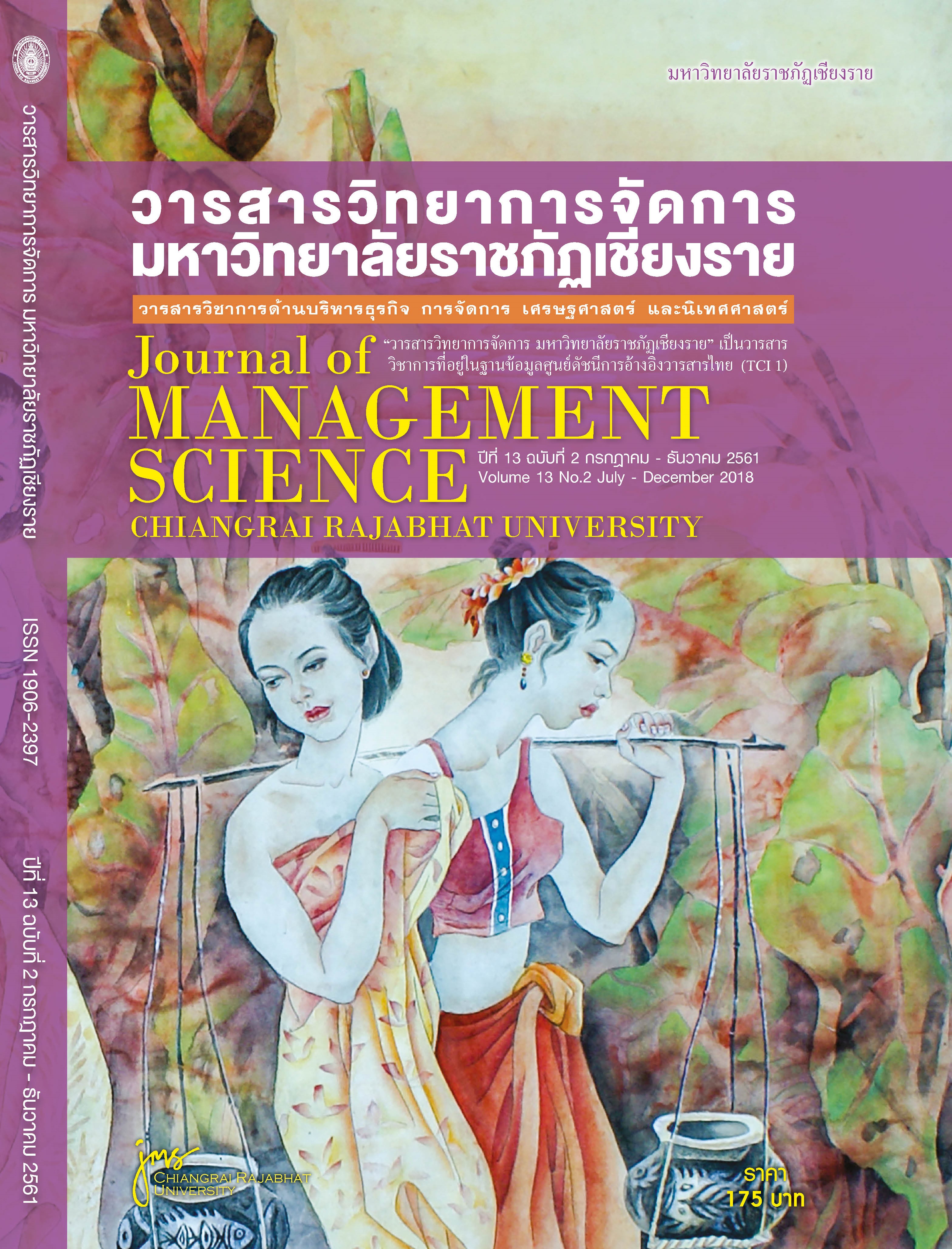ปัจจัยความสำเร็จของผลิตภัณฑ์หนึ่งผลิตภัณณฑ์หนึ่งตำบลของไทย
Main Article Content
บทคัดย่อ
การวิจัยครั้งนี้มีวัตถุประสงค์เพื่อ วิเคราะห์องค์ประกอบเชิงยืนยันของปัจจัยเชิงสาเหตุที่ส่งผลต่อความสำเร็จของผลิตภัณฑ์หนึ่งผลิตภัณฑ์หนึ่งตำบลของไทย และเพื่อศึกษาความสัมพันธ์เชิงสาเหตุตามแบบจำลองสมการโครงสร้าง (Structural Equation Model) ปัจจัยความความสำเร็จของผลิตภัณฑ์หนึ่งผลิตภัณฑ์หนึ่งตำบลของไทย กลุ่มตัวอย่างที่ใช้ในการวิจัยคือ ผู้ประกอบการสินค้าหนึ่งตำบลหนึ่งผลิตภัณฑ์ จำนวน 355 คนใช้วิธีการสุ่มตัวอย่างแบบหลายขั้นตอน เครื่องมือที่ใช้ในการวิจัยเป็นแบบสอบถาม วิเคราะห์ข้อมูลโดยใช้โปรแกรมสำเร็จรูปในการหาค่าสถิติพื้นฐาน และการวิเคราะห์องค์ประกอบเชิงยืนยัน (Confirmatory factor analysis) เพื่อทดสอบความสอดคล้องของโมเดลสมการโครงสร้างของปัจจัยที่ส่งผลต่อความสำเร็จของสินค้าหนึ่งตำบลหนึ่งผลิตภัณฑ์กับข้อมูลเชิงประจักษ์ ผลการวิจัยพบว่า ตัวแปรที่เป็นองค์ประกอบหลักที่มีอิทธิพลต่อความสำเร็จของสินค้าหนึ่งตำบลหนึ่งผลิตภัณฑ์ ประกอบด้วย 5 องค์ประกอบ 1) ด้านการบัญชีและการเงิน 2) ด้านการผลิตและการตลาด 3) ด้านความคิดสร้างสรรค์ 4) ด้านนวัตกรรม และ 5) ความเป็นผู้ประกอบการ ซึ่งทั้ง 5 องค์ประกอบจะต้องปฏิบัติผ่านตัวแปร จำนวน 31 ตัวแปรและตัวชี้วัดความสำเร็จ จำนวน 4 ตัวแปร ปัจจัยที่ส่งผลต่อความสำเร็จของสินค้าหนึ่งตำบลหนึ่งผลิตภัณฑ์ประกอบด้วยตัวบ่งชี้ที่เป็นองค์ประกอบรวม 5 ด้าน เรียงลำดับตามน้ำหนักองค์ประกอบจากมากไปน้อย ได้แก่ ด้านการบัญชีและการเงิน (0.557) ด้านการผลิตและการตลาด (0.533) ด้านความคิดสร้างสรรค์ (0.202) ด้านนวัตกรรม (0.192) และความเป็นผู้ประกอบการ (0.025) ผลการทดสอบความสอดคล้องของโมเดลโครงสร้างปัจจัยที่ส่งผลต่อความสำเร็จของสินค้าหนึ่งตำบลหนึ่งผลิตภัณฑ์ โดยใช้ค่าไค-สแควร์ ค่าดัชนีวัดระดับความกลมกลืน และค่าดัชนีวัดระดับความกลมกลืนที่ปรับแก้แล้ว พบว่า โมเดลมีความสอดคล้องกับข้อมูลเชิงประจักษ์อย่างมีนัยสำคัญทางสถิติ (Chi-Square = 474.372, df = 434, p = 0.088, TLI= .990, CFI= .993, RMSEA= .016, HOELTER = 361)ผลการวิจัยจึงยืนยันสมมติฐานการวิจัยที่กำหนดไว้
Article Details
ทัศนะและข้อคิดเห็นของบทความที่ปรากฏในวารสารฉบับนี้เป็นของผู้เขียนแต่ละท่าน ไม่ถือว่าเป็นทัศนะและความรับผิดชอบของกองบรรณาธิการ
References
Aujirapongpan, S. et al,. (2010). Innovation: meaning, types, and importance to entrepreneur. Business Administration journal. 33(128), p49-65.
Basuony, M. A. (2014). The Balanced Scorecard in large firms and SMEs: A critique of the nature, value and application. Accounting and Finance Research, 3(2), 14.
Carraher, S., Auken, H. (2013). The use of financial statements for decision making by small firms. Journal of Small Business & Entrepreneurship Vol. 26 , Iss. 3,2013
Community Development Department, Ministry of Interior. (2015). A Selection of the Top Thailand's One Tambon One Product. Retrieved on August 2015 from https://www.thaitambon.com Hair, et al., (2010). Multivariate data analysis: A global perspective. (7th edition). New Jersey, NJ: Pearson education Inc.
Hana, U. (2013). Competitive Advantage Achievement through Innovation and Knowledge. Journal of Competitiveness, (1), 82-96.
Hiramatsu, M. (1990). Chihou Kara no Hassou [Idea from a Region]. Tokyo: Iwanami Shoten.
Hofstede, G. (2001). Culture’s consequences: Comparing values, behaviours, institutions, and organizations across nations. (2nd ed.). Thousand Oaks: Sage Publications.
Jiasakul, T. (2557). The problems and the adaptation of OTOP to AEC. Exclusive Journal. Vol.34 no.1 (January - June 2557)
Kotler, P. & Keller, K. L. (2006). Marketing Management. New Jersey: Prentice-Hall.
Kurokawa, K. (2009). Effectiveness and limitations of the “One Village One Product” (OVOP) approach as a government-led development policy: Evidence from Thai OTOP. Journal of the Japan Section of the Regional Science Association International, 39(4), 977-989.
Mamabolo, M.A., Kerrin, M. & Kele, T. (2017). Entrepreneurship management skills requirements in an emerging economy: A South African outlook’, Southern African Journal of Entrepreneurship and Small Business Management 9(1), a111.
Nunnally, J. C. (1978). Psychometric theory (2nd ed.). New York: McGraw-Hill.
Okpara, F. O. (2007). The value of creativity and innovation in entrepreneurship. Journal of Asia Entrepreneurship and Sustainability, 3(2), 81–131.
Peetawan, S. (2546). Financial crisis in Thailand and Z-Score Bankruptcy model. University of the Thai Chamber of commerce Journal. Retrieved on August 2015 from https://www.utcc.ac.th/public_content/files/001/P289_1.pdf
Porter, M. E. (1985). Competitive advantage: Creating and sustaining superior performance. New York: Free press.
Ramanust, S. (2014). A Study of Wealth Creation by the Blue Ocean Strategy:The Case Study of OTOP Entrepreneurs in Thailand. Retrieved from https://www.thonburi-u.ac.th/journal/Document/8-15/15-6-Sumali.pdf
Rinrattanakorn, P., Darawong, C. and Chaichinda, C. (2014). Factors Affecting the Success of OTOP Products in Chon Buri Province Research Methodology & Cognitive Science, Vol. 12, No. 2, October 2014– March 2015. P. 35-45
Roth, A. (1992). Success factors in manufacturing. Business Horizons July-August 1992 pp. 73-81 Retrieved from https://www.business.uzh.ch/professorships/som/stu/Teaching/FS10/MA/som/Roth_Miller_1992_strategy.pdf
Seibert, Z., S. E., & Lumpkin, G. T. (2010). The relationship of personality to entrepreneurial intentions and performance: A meta-analytic review. Journal of Management, 36(2), 381-404.
Seubsman, S., Kelly, M. & Sleigh, A. (2013). The Sufficiency Economy and community sustainability in rural northeastern Thailand. Asian Culture and History, 5(2), 57.
Songini, L, Gnan, L & Malmi, T. (2013). The role and impact of accounting in family business. JOURNAL OF FAMILY BUSINESS STRATEGY, Vol. 4, No. 2, pp. 71-83.
Smith, I. & Tubsree, C. (2016). Leadership development in the One Tambon One Product (OTOP) scheme in Thailand. HRD JOURNAL, 7(1), 36-46.

